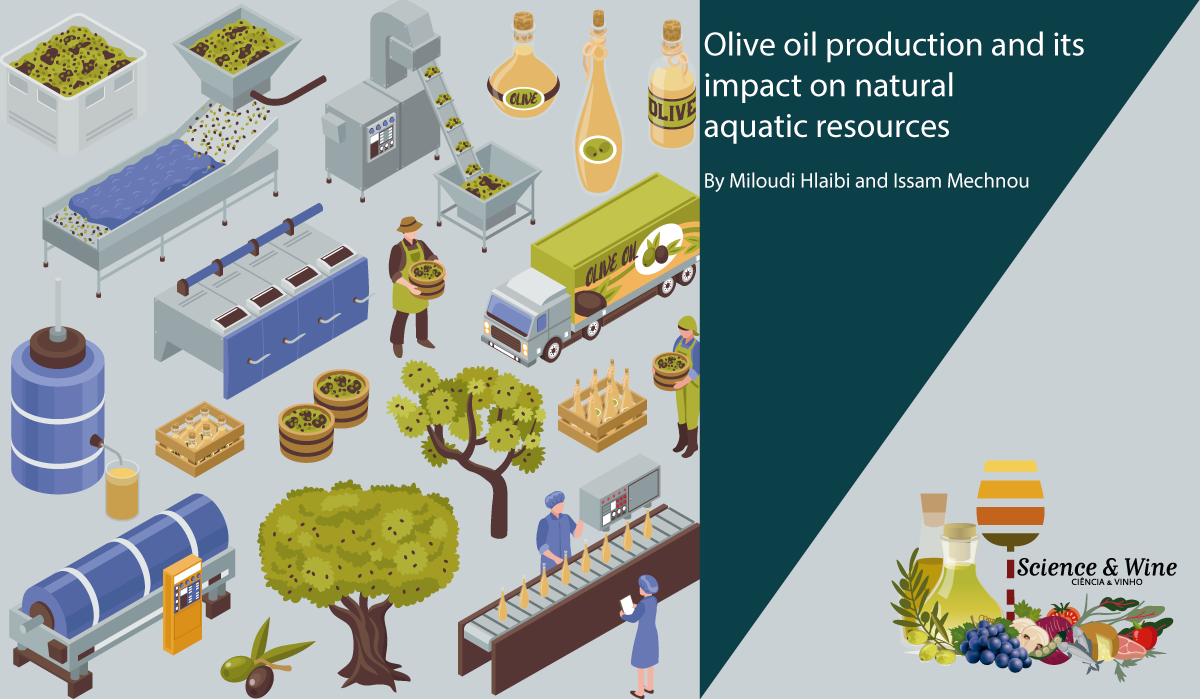By Miloudi Hlaibi and Issam Mechnou
In recent years, the food industry has experienced significant growth. In particular the production of olive oils, which has experienced a significant increase over the last decade, resulting from the high consumption of this food of approximately 3, 056, 500 t / year [1], for its important role as preferred food in the diet of Mediterranean populations. This oil is widely used in body care, in massage, in the preparation of perfumes and in the manufacture of soaps [2]. Today, there are nearly a billion olive trees cultivated in the world, with more than 70% in the Mediterranean basin [3]. However, olives contain around 20% oil, 50% vegetable water and 30% solids [4], regardless of the extraction process type used. The extraction of olive oils by a continuous two-phase system, generates by-products, solids (OMSW) and especially liquid (OMWW) very toxic for the environment.
Olive oil extraction processes are often traditional and generate large quantities of OMWW effluent which can reach 1450 L for one ton of fresh olives treated [5]. This highly toxic effluent is often released without prior treatment, causing serious environmental problems for groundwater, surface water and living species in the aquatic ecosystem, therefore intervention is needed to improve production and sustainability. of this important food [6]. The toxicity of OMWW effluents largely depends on their richness in organic matter, their phytotoxic nature, due to the concentration of polyphenols which can reach 12 g / l, causing destruction of the local flora and fauna, their low biodegradability, justified by a high COD / BOD5 ratio (approximately 8) due to the high concentration of long-chain lipids which can reach up to 70 g / L. The high nitrogen and phosphorus content promotes excessive growth of plants and algae, which consume large amounts of oxygen, thus causing an imbalance of the aquatic ecosystem (eutrophication) [7]. On the other hand, the elimination of OMWW effluents by bio-treatment is almost impossible because their phytotoxic nature affects the used bacterial communities, and promotes the appearance of strains resistant to antibiotics, which can indirectly lead to infectious diseases, incurable to humans and animals [8].

Several studies have been carried out to treat and reduce the pollutant load of these effluents before discharging them into receiving environments. Among the adopted techniques, the treatment by electrocoagulation, this technique allows a reduction of 85% of the COD, 80% of the polyphenols, a dilution of the color of about 5, and an elimination of the suspended matter of the order 8 kg / m3. Despite these important results, this technique requires a voltage of 20 V, approximately 14 kWh / m3 in energy, and generates a loss in mass of the electrodes (0.7 kg /.m3) [9]. Conventional coagulation by adding aluminum sulphate compound (1.5 g / L) at neutral pH, reduces 41% of polyphenols, 40% of COD and 27% of suspended solids [10]. The use of adsorbents such as yellow clay or activated charcoal can reduce up to 100% of COD and 60% of polyphenols [11]. The treatment of OMWW effluents by an advanced H2O2 (1.2 mol / L) / Cu (II) oxidation process under microwaves makes it possible to degrade up to 62% of the phenolic compounds in a treatment time of 65 min [ 12].
On the other hand, these liquid effluents (OMWW) represent a potential source of valorizable biomass because of their richness in organic matter and oils lost during the extraction process. Therefore, valuing this source is an opportunity for the profitability and sustainability of the olive oil industry. Several attempts have been made to enhance the value of these OMWW effluents, such as their use after adequate treatment in agricultural spreading [13], the production of enzymes [14], or the methanization [15]. The proposed methods are very expensive and have low yields, and the anaerobic digestion process is unnecessary because these liquid effluents are difficult to biodegrade because of their high COD / BOD5 ratio. Therefore, adopting physico-chemical methods is not an appropriate choice, as these techniques require pre-treatments, generate by-products, require specific equipment and are economically expensive.

The vegetable waters present liquid effluents OMWW rich in organic matter (around 48%), and thermal processes have become more suitable for efficiently transforming and upgrading these effluents into value-added compounds [16]. In particular, the hydro-carbonization processes of organic matter from vegetable waters in autoclaves at temperatures between 180 and 300 ° C and under self-generated pressures [17]. Thus these OMWW liquid effluents were filtered through a bed of olive pits, the obtained mixture was converted by hydro-thermal carbonization into biochar. This technique exhibited a high carbon recovery of around 84.2% and an overall yield of up to 46.8%, and a reduction in volatile matter of 52.2% [18]. Hydro carbonization of vegetable waters at a temperature of 200 ° C for 24 hours after drying at 120 ° C, has made it possible to recover up to 57% of carbon in the form of charcoal [19]. Our direct carbonization process by flash pyrolysis of OMWW liquid effluents is a new technique with several advantages including economy, cleanliness (without by-products) and speed (30 seconds). This method makes it possible to transform the vegetable waters into clean bio-coal exhibiting important properties with good carbon content and a very high porosity, as well as a carbon recovery of 70% [16]. Up to now, these OMWW liquid effluents constitute a real danger for the environment and a black spot for this industry. The search for new techniques to treat, transform and enhance them is a necessity, and thermal techniques such as flash pyrolysis and hydro-carbonization have proven their effectiveness. These techniques make it possible to transform these highly toxic effluents into a strategic compound with high added value, which constitutes a real additional source of benefits for farmers and extraction units, and ultimately a clean, green and sustainable olive oil production industry.
References
- N. Kalogeropoulos, M. Tsimidou, Antioxidants in Greek Virgin Olive Oils, Antioxidants. 3 (2014) 387–413. https://doi.org/10.3390/antiox3020387.
- M. Torbati, M. Arzanlou, S. Azadmard-damirchi, A. Babai-ahari, S. Alijani, Effect of fungal species involved in the olive fruit rot on the qualitative properties of olive oil, Arch. Phytopathol. Plant Prot. 47 (2014) 292–297. https://doi.org/10.1080/03235408.2013.809183.
- G. Arampatzis, E. Hatzigiannakis, V. Pisinaras, N. Kourgialas, G. Psarras, V. Kinigopoulou, A. Panagopoulos, G. Koubouris, Soil water content and olive tree yield responses to soil management, irrigation, and precipitation in a hilly Mediterranean area, J. Water Clim. Chang. 9 (2018) 672–678. https://doi.org/10.2166/wcc.2018.224.
- C. Nergiz, Y. Engez, Compositional variation of olive fruit during ripening, Food Chem. 69 (2000) 55–59. https://doi.org/10.1016/S0308-8146(99)00238-1.
- A. Elabdouni, K. Haboubi, I. Merimi, M.S.. El Youbi, Olive mill wastewater (OMW) production in the province of Al-Hoceima (Morocco) and their physico-chemical characterization by mill types, Mater. Today Proc. 27 (2020) 3145–3150. https://doi.org/10.1016/j.matpr.2020.03.806.
- G. Enaime, A. Baçaoui, A. Yaacoubi, M. Belaqziz, M. Wichern, M. Lübken, Phytotoxicity assessment of olive mill wastewater treated by different technologies: effect on seed germination of maize and tomato, Environ. Sci. Pollut. Res. 27 (2020) 8034–8045. https://doi.org/10.1007/s11356-019-06672-z.
- G. Hodaifa, A. Malvis, M. Maaitah, S. Sánchez, Combination of physicochemical operations and algal culture as a new bioprocess for olive mill wastewater treatment, Biomass and Bioenergy. 138 (2020) 105603. https://doi.org/10.1016/j.biombioe.2020.105603.
- J.M. Silvan, M.A. Pinto-Bustillos, P. Vásquez-Ponce, M. Prodanov, A.J. Martinez-Rodriguez, Olive mill wastewater as a potential source of antibacterial and anti-inflammatory compounds against the food-borne pathogen Campylobacter, Innov. Food Sci. Emerg. Technol. 51 (2019) 177–185. https://doi.org/10.1016/j.ifset.2018.05.013.
- F. Hanafi, N. Sadif, O. Assobhei, M. Mountadar, Traitement des margines par électrocoagulation avec des électrodes plates en aluminium, Rev. Des Sci. l’eau. 22 (2009) 473–485. https://doi.org/10.7202/038326ar.
- M. Achak, N. Ouazzani, A. Yaacoubi, L. Mandi, Caractérisation des margines issues d’une huilerie moderne et essais de leur traitement par coagulation-floculation par la chaux et le sulfate d’aluminium., Rev. Des Sci. l’eau. 21 (2008) 53–67. https://doi.org/10.7202/017930ar.
- F. Zerrouq, A. Kherbeche, A. Chaqroune, L’effluent des huileries d’olive, traitement par adsorption et par oxydation catalytique, Eur. J. Water Qual. 7 (2002) 53–60.
- H. Iboukhoulef, A. Amrane, H. Kadi, Removal of phenolic compounds from olive mill wastewater by a Fenton-like system H 2 O 2 /Cu(II)—thermodynamic and kinetic modeling, Desalin. Water Treat. 57 (2016) 1874–1879. https://doi.org/10.1080/19443994.2014.978385.
- M. Rinaldi, G. Rana, M. Introna, Olive-mill wastewater spreading in southern Italy: effects on a durum wheat crop, F. Crop. Res. 84 (2003) 319–326. https://doi.org/10.1016/S0378-4290(03)00097-2.
- S. Ertuğrul, G. Dönmez, S. Takaç, Isolation of lipase producing Bacillus sp. from olive mill wastewater and improving its enzyme activity, J. Hazard. Mater. 149 (2007) 720–724. https://doi.org/10.1016/j.jhazmat.2007.04.034.
- L. Pontoni, G. D’Antonio, G. Esposito, M. Fabbricino, L. Frunzo, F. Pirozzi, Thermal pretreatment of olive mill wastewater for efficient methane production: control of aromatic substances degradation by monitoring cyclohexane carboxylic acid, Environ. Technol. 36 (2015) 1785–1794. https://doi.org/10.1080/09593330.2015.1012179.
- I. Mechnou, I. Mourtah, Y. Raji, A. Chérif, L. Lebrun, M. Hlaibi, Effective treatment and the valorization of solid and liquid toxic discharges from olive oil industries, for sustainable and clean production of bio-coal, J. Clean. Prod. (2020) 125649. https://doi.org/10.1016/j.jclepro.2020.125649.
- J. Wang, C. Sun, B.-C. Lin, Q.-X. Huang, Z.-Y. Ma, Y. Chi, J.-H. Yan, Micro- and mesoporous-enriched carbon materials prepared from a mixture of petroleum-derived oily sludge and biomass, Fuel Process. Technol. 171 (2018) 140–147. https://doi.org/10.1016/j.fuproc.2017.11.013.
- G. Enaime, A. Baçaoui, A. Yaacoubi, M. Wichern, M. Lübken, Hydrothermal carbonization of the filter bed remained after filtration of olive mill wastewater on olive stones for biofuel application, Biomass Convers. Biorefinery. (2020). https://doi.org/10.1007/s13399-020-00743-9.
- A.A. Azzaz, M. Jeguirim, V. Kinigopoulou, C. Doulgeris, M.L. Goddard, S. Jellali, C. Matei Ghimbeu, Olive mill wastewater: From a pollutant to green fuels, agricultural and water source and bio-fertilizer – Hydrothermal carbonization, Sci. Total Environ. 733 (2020). https://doi.org/10.1016/j.scitotenv.2020.139314.

